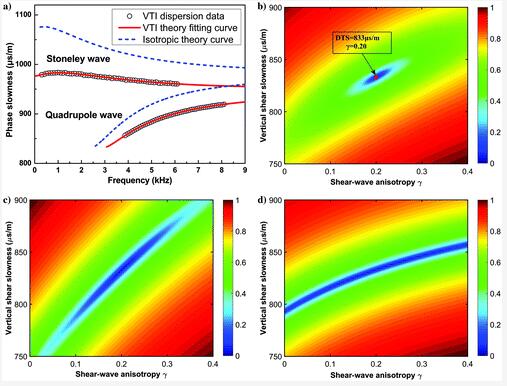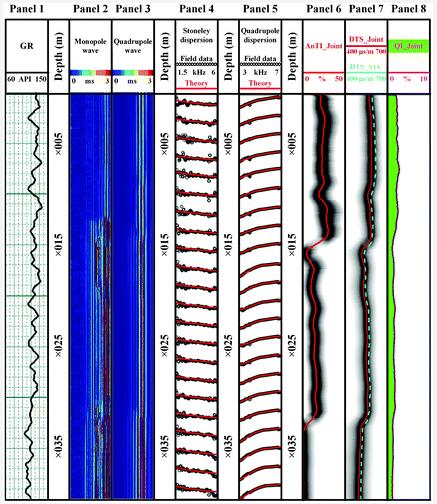Recently, the Society of Exploration Geophysicists (SEG) announced its Honors and Awards Nominations in 2020. A paper published by Prof. Tang Xiaoming' Group inGeophysics, was selected to receive Honorable Mention for Best Paper, Which is the first award-winning paper with domestic unit as the first signing unit since the award was established in 1987.
The paper is entitled Joint inversion of logging-while-drilling multipole acoustic data to determine formation shear-wave transverse isotropy. Doctoral student Yanghu Li from the school of Geosciences is the first author of the paper, Prof. Yuanda Su is the corresponding author, and China University of Petroleum (East China) is the first signing unit.
Geophysical data inversion faces two typical problems, one is the multiple parameter nature of the theoretical model, and the other is the nonuniqueness of the inversion result. The paper developed effective solutions to these two problems. The approach to the first problem is singling out the most important parameter(s) and reducing the size of the problem. The solution to the nonuniqueness problem is combining data from different measurements that have sensitivity to the parameter(s) of interest.As exemplified by the present LWD acoustic data inversion for VTI anisotropy. First of all, using sensitivity analysis, one can identify that the two shear moduliC44andC66are the most sensible parameters for the inversion and, by using ANNIE approximation, the five-parameter (C11,C13,C33,C44andC66) VTI problem can be reduced into a two-parameter (C44andC66) inversion problem. This approach greatly reduces the difficulty of the problem and is efficient for field data processing. Furthermore, for the LWD situation, although the monopole Stoneley and quadrupole waves are sensitive to the formation anisotropy parametersC44andC66, they suffer from the typical nonuniqueness problem when using the individual-wave data to invert parameters alone. By combining the two waves in the joint inversion, the ability to resolve the anisotropy parameters is much improved, meanwhile, the nonuniqueness problem in the parameter inversion can be effectively alleviated. The correctness and feasibility of the method has been verified by the processing results of theoretical synthetic data (Figure 1) and field LWD acoustic-wave data (Figure 2). This paper is highly evaluated by journal editor and reviewers, and it is considered that the result of this paper offers an effective method for evaluating VTI formation anisotropy from acoustic LWD data, and more importantly, the method has reference significance for geophysical inversion problems.

Fig.1 Test of the joint inversion method using synthetic-wave dispersion data in (a) (circles) and (b) VD display of the objective function, showing a well-defined solution minimum. The calculated dispersion curves from the solution (solid) fit the data very well. The VD images in (c and d) are the objective function for the Stoneley and quadrupole, respectively. The elongated valleys of the images indicate the nonuniqueness problem for inverting the individual wave data.

Fig.2 Example of the joint inversion method for field data using the LWD monopole (panel 2) and quadrupole (panel 3) wave data. Panels 4 and 5 display the dispersion data fitting of the Stoneley and quadrupole waves, respectively. Panels 6 and 7 show the inversion results. Panel 8 predicts the quality indicators of the inversion results.
Founded in 1930 and headquartered in Oklahoma, USA, SEG is committed to promoting the development and international exchange of geoscience and petroleum exploration disciplines worldwide.Geophysicsis the flagship journal published by SEG, and the research articles accepted are of great influence in the field of international exploration geophysics.Geophysics selects 4 papers from approximately 400 papers published in it every year, which are nominated by the nomination committee, recommended by the review committee and voted by the editorial board, to receive Honorable Mention for Best Paper.
The Acoustic Logging Group led by Prof. Xiaoming Tang carried out researches on acoustic logging method, theory and technology around the major scientific and technological problems and needs of national oil and gas resources exploration.At present, a number of achievements of this group are pioneering in the world, making the development of acoustic logging technology in China at the forefront of the world. In recent years, they have published more than 100 SCI papers in authoritative journals at home and abroad, such asGeophysical Research Letters, JGR: Solid Earth,Geophysical Journal International,Geophysics, andScience China Earth Sciences.In addition, the group has trained more than 80 people with master and doctoral degrees, forming an important international influence in the field of geophysical logging.
Link to paper:https://library.seg.org/doi/10.1190/geo2019-0611.1